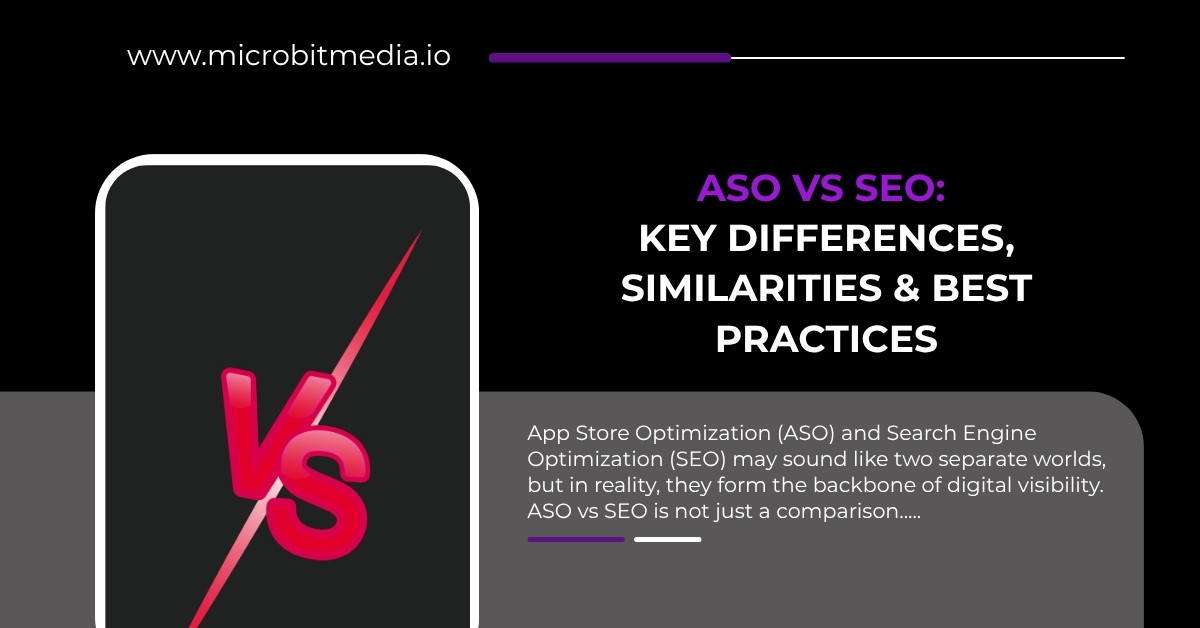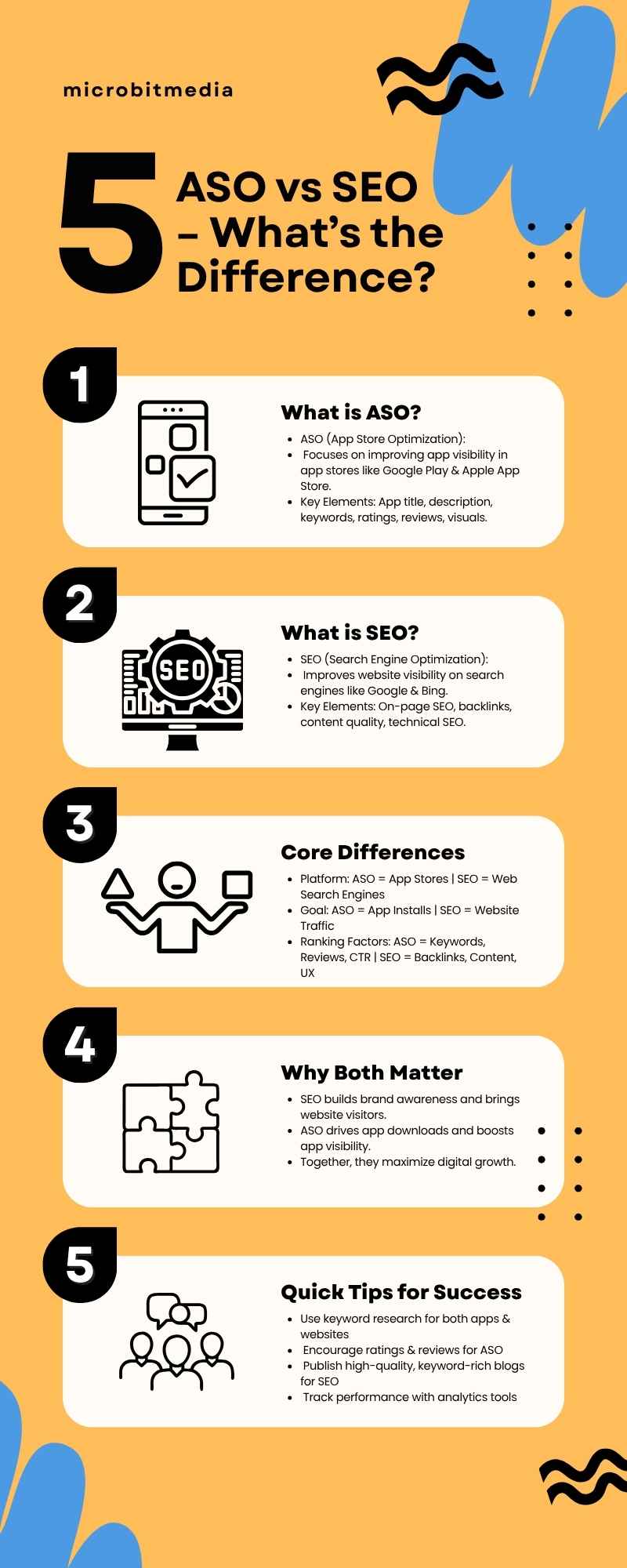Last updated on October 8th, 2025 at 06:35 am
App Store Optimization (ASO) and Search Engine Optimization (SEO) may sound like two separate worlds, but in reality, they form the backbone of digital visibility. ASO vs SEO is not just a comparison; it’s a question of how brands want to be discovered, whether inside app stores or across the web. ASO focuses on improving an app’s rankings in platforms like Google Play or Apple’s App Store, while SEO ensures that websites surface prominently on search engines like Google. In today’s mobile-first and web-first era, relying on one without the other can limit reach. Together, these optimization strategies drive sustainable digital growth by ensuring visibility wherever your audience is searching.
What is ASO (App Store Optimization)?
App Store Optimization (ASO) is all about boosting an app’s visibility on platforms like Google Play and the Apple App Store. Think of it as the app world’s version of SEO. While SEO helps websites climb search rankings, ASO ensures apps appear higher in app store searches and attract more downloads. In the debate of ASO vs SEO, the ultimate aim is the same—greater visibility—but the methods vary depending on whether you’re optimizing for a website or an app.
Core Elements of ASO
App Title & Subtitle Optimization: Choosing a compelling, keyword-rich title and subtitle helps apps stand out in crowded marketplaces.
Keywords in Description & Metadata: Strategically placing keywords boosts discoverability and strengthens app visibility in stores.
App Icon, Screenshots & Videos: Visuals play a vital role in user decisions. High-quality icons and engaging previews enhance appeal.
Ratings, Reviews & User Retention: Positive reviews and high retention rates build trust, increasing the likelihood of consistent growth.
What is SEO (Search Engine Optimization)?
Search Engine Optimization (SEO) is the practice of improving a website’s visibility in search engines to attract more organic traffic. When people ask what is SEO or search for SEO meaning, they’re essentially looking for techniques that can help their site rank higher in Google and other search engines.
Core Elements of SEO
On-Page SEO: It focuses on elements you control directly: meta titles, headings, structured content, and keyword placement. Strong on-page practices ensure your pages align with search intent.
Off-Page SEO: Here, backlinks, brand mentions, and domain authority signal credibility to search engines, boosting rankings.
Technical SEO: Site speed, mobile optimization, and proper indexing form the foundation for search ranking factors.
UX & Engagement Signals: User experience time on site, navigation ease, and engagement directly impact visibility.
In digital strategy, understanding SEO techniques is as essential as knowing ASO, vs SEO both drive discoverability, but in different ecosystems.
ASO vs SEO: Key Differences You Must Know
When businesses think about digital visibility, two strategies dominate the conversation: ASO vs SEO. While both aim to increase discovery, their platforms, techniques, and results differ. Understanding this distinction helps marketers craft the right approach, whether for apps or websites.
ASO vs SEO Differences in a Snapshot
Below is a clear SEO vs ASO comparison that highlights the major differences.
| Factor | ASO (App Store Optimization) | SEO (Search Engine Optimization) |
| Platform | Focused on app stores like Google Play & Apple App Store | Works on search engines like Google, Bing, Yahoo |
| Primary Goal | Increase app installs and visibility | Drive organic website traffic |
| Keywords | Optimized in app title, description, and tags | Used in website content, meta tags, and backlinks |
| Ranking Signals | App reviews, ratings, downloads, retention | Backlinks, site authority, on-page optimization |
| Content Type | Screenshots, app previews, in-app experience | Blogs, landing pages, product descriptions |
| User Intent | High—users already plan to download or try apps | Mixed—informational, transactional, navigational searches |
| Metrics Tracked | Installs, ratings, retention, conversions | Traffic, bounce rate, keyword rankings, conversions |
| Cost Effectiveness | Strong for long-term app growth | Vital for sustained website authority |
| Best Use Case | App marketing, mobile-first businesses | Website marketing, e-commerce, content-driven brands |
Why the Comparison Matters
In today’s digital world, brands can’t afford to ignore either. ASO vs SEO differences reveal that while SEO strengthens website presence, ASO ensures apps don’t get buried in crowded app stores. Together, they create a unified funnel that SEO can drive users to the app’s landing page, and ASO can ensure high conversion inside the store.
For startups and businesses relying on apps, ASO is non-negotiable\. For content-heavy industries like e-commerce or publishing, SEO is the backbone. But the most effective strategies combine both.
ASO vs SEO: Surprising Similarities
When marketers compare ASO vs SEO, they often focus on the differences. Yet, the real surprise lies in how much these two strategies share in common. Both aim to drive visibility, attract the right audience, and build long-term growth. Let’s break down the key connections:
- Keywords as the foundation
- Both ASO and SEO depend heavily on keyword research. Just as SEO requires identifying search terms for web pages, ASO relies on app-related keywords that influence ranking in app stores.
- Content optimization is crucial.
- Whether it’s website blogs or app descriptions, both demand clear, engaging, and keyword-rich content. Optimized content ensures algorithms understand relevance while users get the right first impression.
- User trust signals matter.
- In SEO, factors like backlinks and engagement build credibility. In ASO, reviews and ratings act as trust indicators. Both reward brands that earn genuine user approval.
- Continuous optimization is the rule.
- Algorithms evolve constantly. SEO strategies need updates to maintain rankings, while ASO requires regular tweaks in visuals, metadata, and keywords to stay competitive.
In the ASO vs SEO conversation, the similarities are more powerful than the differences. Both rely on keyword accuracy, content quality, user trust, and ongoing effort. Understanding the ASO vs SEO connection allows businesses to create unified strategies that boost visibility across search engines and app stores alike.
ASO vs SEO: Which One Should You Focus On?
When businesses debate ASO vs SEO, the real question isn’t which is better; it’s which one matters more for your specific goals. Both strategies serve different purposes, and understanding when to prioritize one over the other can define the success of your digital growth.
When to Prioritize ASO
If you’re launching a new app, App Store Optimization (ASO) should be your priority. It directly impacts how easily users discover your app within app stores. For businesses with a mobile-first audience, ASO ensures your product ranks higher in app store searches, improves conversion with better visuals and keywords, and ultimately boosts downloads. In short, if your main product lives in the app ecosystem, ASO is non-negotiable.
When to Prioritize SEO
If your focus is on a website, blog, or e-commerce platform, then Search Engine Optimization (SEO) is the way forward. SEO builds long-term, compounding traffic by helping your pages rank on Google. It’s particularly powerful when your aim is brand visibility, authority building, or driving consistent organic traffic. If the question is ASO vs SEO for apps vs websites, the answer depends on whether your primary digital presence is an app or a site.
Can You Combine Both?
The smartest brands don’t choose between ASO and SEO; they integrate them. Use SEO to generate awareness through web content, then leverage ASO to convert that awareness into app installs. For example, blogs optimized for search can introduce users to your product, while strong ASO ensures those same users download your app.
In today’s competitive landscape, ASO vs SEO isn’t an either/or battle. Instead, it’s about aligning both strategies with your growth funnel: SEO for visibility, ASO for conversions.
Case Studies: How Brands Use ASO & SEO Together
When it comes to visibility, brands no longer debate ASO vs SEO; they combine both. Real-world success stories show how integrating app store optimization with search engine optimization creates a flywheel effect that drives installs and long-term growth.
Leveraging Content Marketing + ASO Optimization
A leading meditation app offers a great example. While its app store page was optimized with relevant keywords, compelling screenshots, and strong ratings, the brand also invested in SEO content. Blogs on mindfulness, sleep habits, and stress relief ranked highly on Google, feeding a steady stream of traffic toward its app download page. This dual play of ASO vs SEO ensured that the brand captured both organic app store searches and web-based intent.
E-Commerce Apps Driving Maximum Exposure
E-commerce platforms have been particularly effective at merging strategies. For example, an online fashion marketplace optimized its Play Store and App Store presence with seasonal keywords like “Diwali fashion” or “summer sales.” Simultaneously, its website was structured around SEO-friendly landing pages, style guides, and shopping trends. When users searched on Google, they were directed to high-ranking web pages; when they searched in app stores, ASO brought the app to the top. This seamless blend of ASO vs SEO created a funnel where discovery on the web naturally translated into app installs.
The Takeaway
These ASO SEO case studies prove that brands that integrate both strategies don’t just compete, they dominate. By aligning keyword strategies, user journeys, and content across web and app ecosystems, companies create ASO SEO success stories that redefine visibility and growth.
Best Practices to Balance ASO and SEO in 2025
Balancing ASO vs SEO is no longer optional; it’s essential for brands that want visibility across both app stores and search engines. Here’s a practical checklist to align strategies:
- Track Keywords Across Platforms
- Use unified tools to monitor keyword rankings in app stores and Google SERPs.
- Compare performance and adapt what ranks in ASO vs SEO may differ, but both inform stronger targeting.
- Leverage App Landing Pages
- Create SEO-driven landing pages for your apps.
- Optimize with keywords, fast-loading design, and CTAs that drive users from web searches directly to installs.
- Balance Reviews and Backlinks
- Encourage consistent user reviews to boost app store rankings.
- Simultaneously build high-quality backlinks to strengthen domain authority. This dual push merges the impact of ASO vs SEO.
- Test and Refine Creatives
- In app stores, test screenshots, icons, and preview videos.
- On the web, A/B test thumbnails and meta visuals. User engagement fuels algorithm trust in both ecosystems.
- Align Messaging Across Channels
- Keep app descriptions, titles, and website content consistent.
- A clear brand voice ensures higher trust and better discoverability.
Key Takeaways – ASO vs SEO in 2025
ASO vs SEO are not competitors but complements. While SEO builds long-term brand visibility through search engines, ASO drives app installs and user acquisition directly inside app stores. In 2025, ASO vs SEO strategies are merging as brands aim for a stronger omnichannel presence. Users discover brands via Google search and convert inside app stores. SEO ensures authority, trust, and organic ranking that sustains over the years, while ASO creates immediate conversion opportunities through optimized titles, visuals, and reviews. Companies integrating both gain a competitive edge: SEO fuels awareness, ASO captures intent, together strengthening the digital marketing strategies 2025 playbook. The winning formula isn’t choosing ASO vs SEO, but aligning them to deliver visibility, engagement, and growth across every digital touchpoint.
Conclusion
When it comes to ASO vs SEO, the conversation should never be about choosing one and ignoring the other. Both play a vital role in shaping how users discover, trust, and engage with your brand, one inside app stores, the other across search engines. Treating them as rivals limits growth; integrating them unlocks a full-funnel approach where visibility and conversion reinforce each other. The future of digital marketing lies in combining the strengths of both. By unifying ASO vs SEO strategies, marketers can ensure consistent brand presence, maximize organic reach, and future-proof campaigns in an increasingly competitive landscape. In short, ASO vs SEO isn’t a choice; it’s a partnership.



